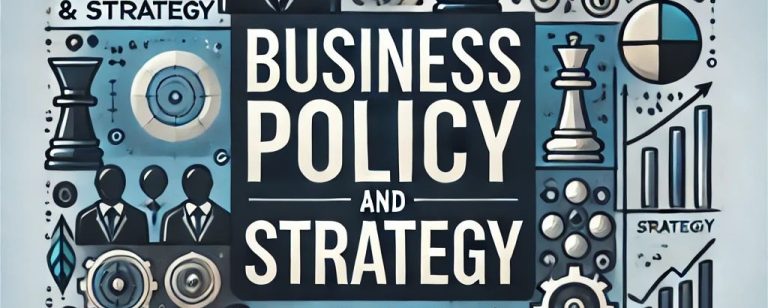Understanding business policy and strategy is essential for any organization aiming to achieve long-term goals and sustainable growth. Business policy is a guide to decision-making strategies, whereas strategies can be defined as the actual work plans in pursuing such goals. Together, they outline how companies should understand market dynamics, manage resources appropriately, and compete in this market. Knowing the essential elements of business policy and strategy thus enables firms to line up its goals with the targeted market demands in order to pursue a line of success amid a rapidly changing environment. Therefore, together they are the basic framework for effective business operation.
What is Business Policy?
A business policy refers to a set of rules, guidelines, and frameworks that direct decision-making and actions in an organization. These policies ensure consistency, provide a reference point for employees, and establish boundaries for operations. Business policies guide the “what” and “why” behind an organization’s decisions.
Features of Business Policy
Business policies are essential for guiding employees and maintaining consistency in an organization. They provide a clear framework to ensure decisions align with the company’s goals and values.
- Guidance for Decisions: Policies serve as a reference for employees to make decisions that align with the organization’s goals. They simplify complex situations by providing clear directions and ensuring actions support the company’s vision.
- Flexibility with Structure: Policies are flexible enough to adapt to changing circumstances but structured to maintain consistency. This balance helps businesses stay prepared for changes while ensuring a stable work environment.
- Defined Boundaries: Policies establish clear limits on actions to ensure ethical and legal compliance. They protect the company’s reputation by guiding employees on acceptable behavior and decision-making.
- Universal Application: Business policies apply across all levels of the organization, ensuring alignment among teams. They create a unified approach to operations, helping everyone work towards common goals efficiently.
What is Strategy?
A strategy is a comprehensive plan or action aimed at achieving specific organizational goals. It involves analyzing the current situation, setting objectives, and identifying the best methods to achieve them. Unlike policies, strategies focus on the “how” and “when” of achieving goals.
Key Features of Strategy
Strategies play a key role in helping businesses achieve their goals and stay competitive. They provide a clear plan of action, ensuring businesses adapt, execute, and succeed in changing market conditions.
- Goal-Oriented: A strategy is designed to achieve defined goals within a specified timeframe. It provides a clear direction and helps businesses stay focused on their objectives, ensuring measurable progress.
- Dynamic and Adaptive: Strategies evolve based on market conditions and organizational needs. They help businesses respond to changes quickly, making them more resilient and competitive in a fast-changing environment.
- Focus on Execution: Strategies emphasize implementation and resource allocation. They ensure that teams work efficiently, using available resources effectively to achieve desired outcomes.
- Competitive Advantage: The ultimate aim of a strategy is to gain and sustain an advantage in the marketplace. It helps businesses stand out by identifying unique strengths and delivering greater value to customers.
Difference Between Business Policy and Strategy
While business policy and strategy are interconnected, they have distinct characteristics. Here are five key differences:
Definition
- Business Policy: Business policies provide guidelines for decision-making within an organization. They focus on setting boundaries and ensuring all actions align with the company’s vision and mission.
- Strategy: Strategies are actionable plans that help businesses achieve their goals. They outline specific steps to overcome challenges and seize opportunities effectively.
Focus
- Business Policy: Business policies focus on answering “what” the organization aims to do and “why” it is important. They provide a framework for decisions at all levels.
- Strategy: Strategies focus on “how” to achieve objectives and “when” to execute specific actions. They emphasize detailed planning and execution to meet business goals.
Scope
- Business Policy: Policies are broad and generic in nature. They apply to multiple areas of the business and guide long-term decision-making.
- Strategy: Strategies are specific and goal-oriented. They are designed to address particular challenges or achieve distinct objectives in a targeted manner.
Flexibility
- Business Policy: Policies are relatively stable over time. They offer consistency and do not change frequently, providing a strong foundation for the organization.
- Strategy: Strategies are dynamic and adaptable. They change based on market trends, competition, and evolving business needs to ensure success.
Purpose
- Business Policy: Policies aim to ensure consistency and structure within the organization. They establish a unified approach to decision-making and operations.
- Strategy: Strategies aim to achieve a competitive advantage. They help businesses stay ahead in the market by focusing on innovation and effective execution.
| Aspect | Business Policy | Strategy |
| Definition | Guidelines for decision-making. | Actionable plans to achieve goals. |
| Focus | Focuses on “what” and “why.” | Focuses on “how” and “when.” |
| Scope | Broad and generic. | Specific and goal-oriented. |
| Flexibility | Relatively stable over time. | Dynamic and adaptable. |
| Purpose | Ensures consistency and structure. | Achieves competitive advantage. |
Business Policy and Strategy FAQs
What is the relationship between business policy and strategy?
Business policy provides the guidelines, while strategy outlines the actions needed to achieve specific goals. Policies ensure consistency, and strategies focus on execution.
What is the main difference between business policy and strategy?
The main difference lies in focus: policies address “what” and “why,” while strategies address “how” and “when” to achieve objectives.
Can business policy and strategy change over time?
Yes, while business policies are relatively stable, strategies frequently adapt to market trends, competition, and organizational needs.
Why are both business policy and strategy important?
Policies ensure structured decision-making, while strategies enable the achievement of objectives. Together, they create a balanced approach to management.
What are some examples of business policy vs strategy?
Policy: Code of conduct for employees. Strategy: Expanding into new markets to increase revenue.


